MGT723 Research: Incentives & Carbon Emission Relationship
VerifiedAdded on 2023/06/04
|7
|1975
|287
Report
AI Summary
This research report investigates the relationship between providing employee incentives for climate change initiatives and the resulting reduction in carbon dioxide (CO2) emissions, focusing on the Forest and Paper Products Industry and the Air Freight Transportation Industry. Using chi-square analysis, the study examines whether a significant association exists between these variables. The findings indicate no significant correlation between the provision of incentives and the reduction of carbon emissions in either industry, leading to the acceptance of the null hypothesis. The report discusses these results in light of existing literature, highlighting the need for further research into effective strategies for curbing emissions, such as reducing gasoline consumption and promoting alternative energy sources. The limitations of the study include a small sample size and a narrow focus on incentives, suggesting avenues for future research involving larger samples, broader industry coverage, and consideration of additional factors influencing carbon emission reduction.
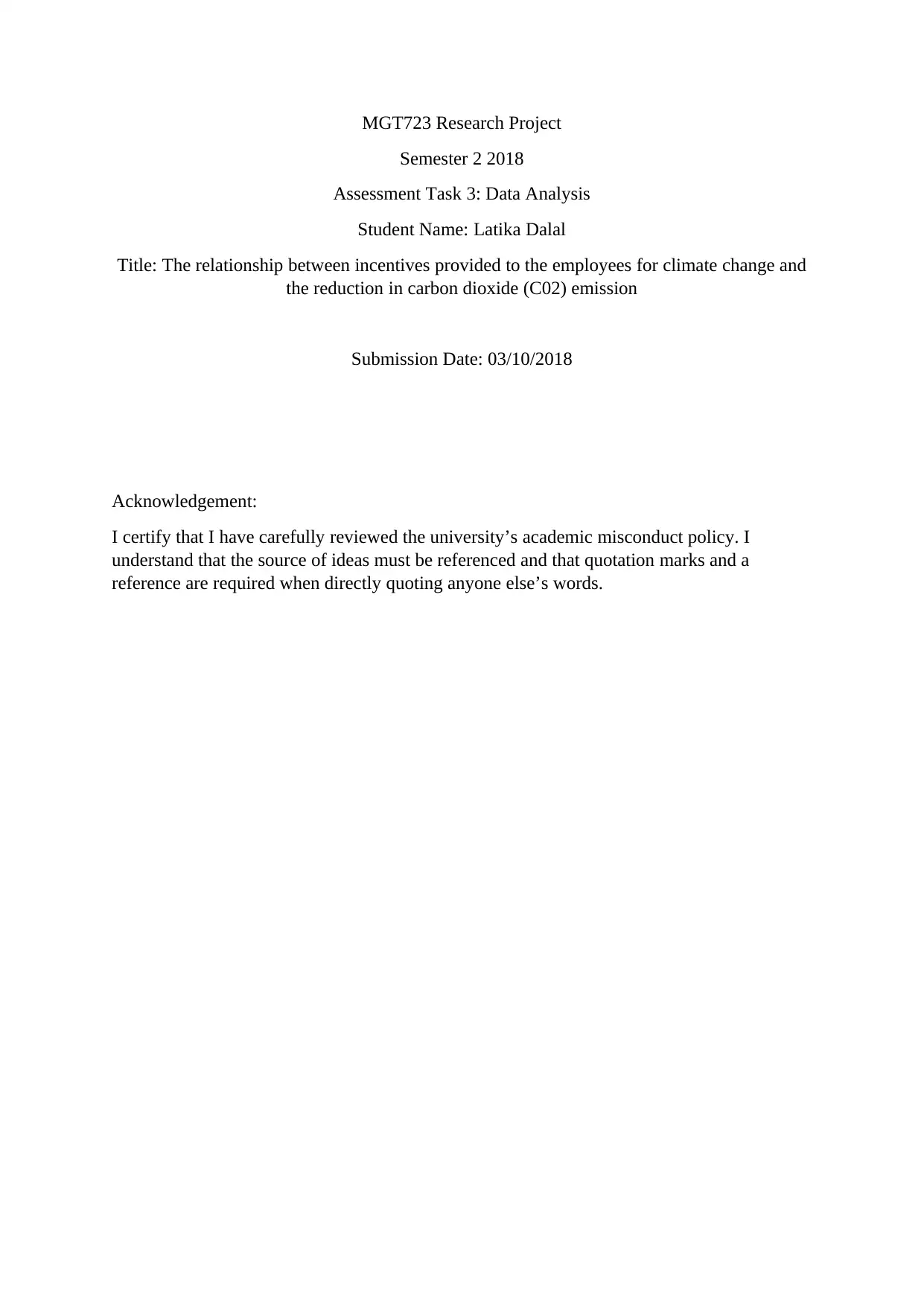
MGT723 Research Project
Semester 2 2018
Assessment Task 3: Data Analysis
Student Name: Latika Dalal
Title: The relationship between incentives provided to the employees for climate change and
the reduction in carbon dioxide (C02) emission
Submission Date: 03/10/2018
Acknowledgement:
I certify that I have carefully reviewed the university’s academic misconduct policy. I
understand that the source of ideas must be referenced and that quotation marks and a
reference are required when directly quoting anyone else’s words.
Semester 2 2018
Assessment Task 3: Data Analysis
Student Name: Latika Dalal
Title: The relationship between incentives provided to the employees for climate change and
the reduction in carbon dioxide (C02) emission
Submission Date: 03/10/2018
Acknowledgement:
I certify that I have carefully reviewed the university’s academic misconduct policy. I
understand that the source of ideas must be referenced and that quotation marks and a
reference are required when directly quoting anyone else’s words.
Paraphrase This Document
Need a fresh take? Get an instant paraphrase of this document with our AI Paraphraser
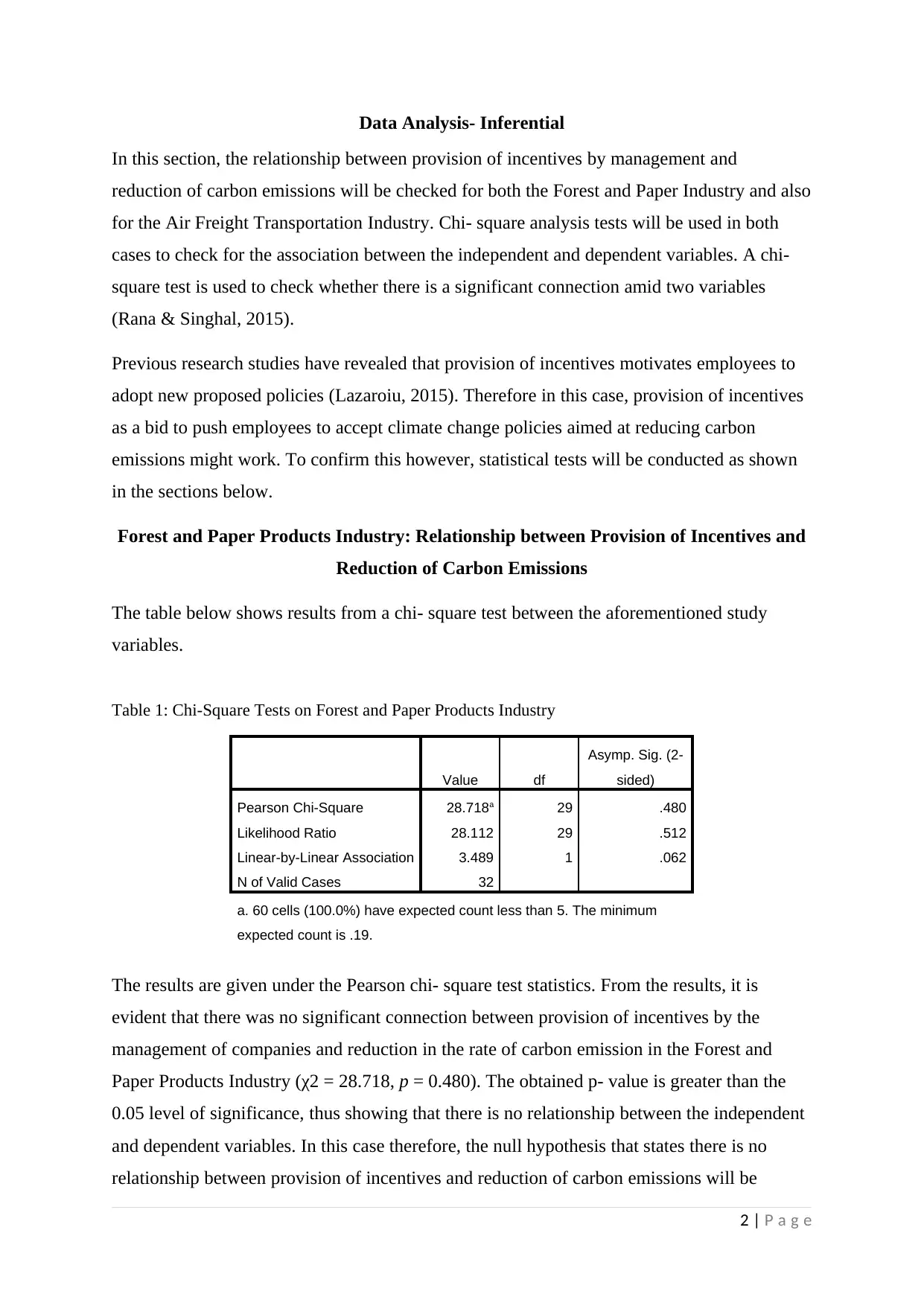
Data Analysis- Inferential
In this section, the relationship between provision of incentives by management and
reduction of carbon emissions will be checked for both the Forest and Paper Industry and also
for the Air Freight Transportation Industry. Chi- square analysis tests will be used in both
cases to check for the association between the independent and dependent variables. A chi-
square test is used to check whether there is a significant connection amid two variables
(Rana & Singhal, 2015).
Previous research studies have revealed that provision of incentives motivates employees to
adopt new proposed policies (Lazaroiu, 2015). Therefore in this case, provision of incentives
as a bid to push employees to accept climate change policies aimed at reducing carbon
emissions might work. To confirm this however, statistical tests will be conducted as shown
in the sections below.
Forest and Paper Products Industry: Relationship between Provision of Incentives and
Reduction of Carbon Emissions
The table below shows results from a chi- square test between the aforementioned study
variables.
Table 1: Chi-Square Tests on Forest and Paper Products Industry
Value df
Asymp. Sig. (2-
sided)
Pearson Chi-Square 28.718a 29 .480
Likelihood Ratio 28.112 29 .512
Linear-by-Linear Association 3.489 1 .062
N of Valid Cases 32
a. 60 cells (100.0%) have expected count less than 5. The minimum
expected count is .19.
The results are given under the Pearson chi- square test statistics. From the results, it is
evident that there was no significant connection between provision of incentives by the
management of companies and reduction in the rate of carbon emission in the Forest and
Paper Products Industry (χ2 = 28.718, p = 0.480). The obtained p- value is greater than the
0.05 level of significance, thus showing that there is no relationship between the independent
and dependent variables. In this case therefore, the null hypothesis that states there is no
relationship between provision of incentives and reduction of carbon emissions will be
2 | P a g e
In this section, the relationship between provision of incentives by management and
reduction of carbon emissions will be checked for both the Forest and Paper Industry and also
for the Air Freight Transportation Industry. Chi- square analysis tests will be used in both
cases to check for the association between the independent and dependent variables. A chi-
square test is used to check whether there is a significant connection amid two variables
(Rana & Singhal, 2015).
Previous research studies have revealed that provision of incentives motivates employees to
adopt new proposed policies (Lazaroiu, 2015). Therefore in this case, provision of incentives
as a bid to push employees to accept climate change policies aimed at reducing carbon
emissions might work. To confirm this however, statistical tests will be conducted as shown
in the sections below.
Forest and Paper Products Industry: Relationship between Provision of Incentives and
Reduction of Carbon Emissions
The table below shows results from a chi- square test between the aforementioned study
variables.
Table 1: Chi-Square Tests on Forest and Paper Products Industry
Value df
Asymp. Sig. (2-
sided)
Pearson Chi-Square 28.718a 29 .480
Likelihood Ratio 28.112 29 .512
Linear-by-Linear Association 3.489 1 .062
N of Valid Cases 32
a. 60 cells (100.0%) have expected count less than 5. The minimum
expected count is .19.
The results are given under the Pearson chi- square test statistics. From the results, it is
evident that there was no significant connection between provision of incentives by the
management of companies and reduction in the rate of carbon emission in the Forest and
Paper Products Industry (χ2 = 28.718, p = 0.480). The obtained p- value is greater than the
0.05 level of significance, thus showing that there is no relationship between the independent
and dependent variables. In this case therefore, the null hypothesis that states there is no
relationship between provision of incentives and reduction of carbon emissions will be
2 | P a g e

accepted. This provides a possibility of type 2 error, which is an error of accepting a null
hypothesis that is wrong (Hopkins, 2017). However, this error is small in this case, since the
sample size used is large enough to detect any relationships between provision of incentives
and reduction of carbon emissions.
Air Freight Industry: Relationship between Provision of Incentives and Reduction of
Carbon Emissions
The table below shows results from a chi- square test between the aforementioned study
variables.
Table 2: Chi-Square Tests on Air Freight Industry
Value df
Asymp. Sig. (2-
sided)
Pearson Chi-Square 32.000a 30 .368
Likelihood Ratio 27.738 30 .584
Linear-by-Linear Association .102 1 .749
N of Valid Cases 32
a. 62 cells (100.0%) have expected count less than 5. The minimum
expected count is .16.
The results are given under the Pearson chi- square test statistics. From the results, it is
evident that there was no significant connection between provision of incentives by the
management of companies and reduction in the rate of carbon emission in the Air Freight
Industry (χ2 = 32.000, p = 0.368). The obtained p- value is greater than the 0.05 level of
significance, thus showing that there is no relationship between the independent and
dependent variables. The null hypothesis that states no relationship exists between provision
pf incentives and reduction of carbon emissions is accepted. This, just like in the section
above, creates a chance of committing a type 2 error. But as stated before, the utilized sample
size is big enough to detect any significant connection between the independent variable and
the dependent variable.
3 | P a g e
hypothesis that is wrong (Hopkins, 2017). However, this error is small in this case, since the
sample size used is large enough to detect any relationships between provision of incentives
and reduction of carbon emissions.
Air Freight Industry: Relationship between Provision of Incentives and Reduction of
Carbon Emissions
The table below shows results from a chi- square test between the aforementioned study
variables.
Table 2: Chi-Square Tests on Air Freight Industry
Value df
Asymp. Sig. (2-
sided)
Pearson Chi-Square 32.000a 30 .368
Likelihood Ratio 27.738 30 .584
Linear-by-Linear Association .102 1 .749
N of Valid Cases 32
a. 62 cells (100.0%) have expected count less than 5. The minimum
expected count is .16.
The results are given under the Pearson chi- square test statistics. From the results, it is
evident that there was no significant connection between provision of incentives by the
management of companies and reduction in the rate of carbon emission in the Air Freight
Industry (χ2 = 32.000, p = 0.368). The obtained p- value is greater than the 0.05 level of
significance, thus showing that there is no relationship between the independent and
dependent variables. The null hypothesis that states no relationship exists between provision
pf incentives and reduction of carbon emissions is accepted. This, just like in the section
above, creates a chance of committing a type 2 error. But as stated before, the utilized sample
size is big enough to detect any significant connection between the independent variable and
the dependent variable.
3 | P a g e
⊘ This is a preview!⊘
Do you want full access?
Subscribe today to unlock all pages.

Trusted by 1+ million students worldwide
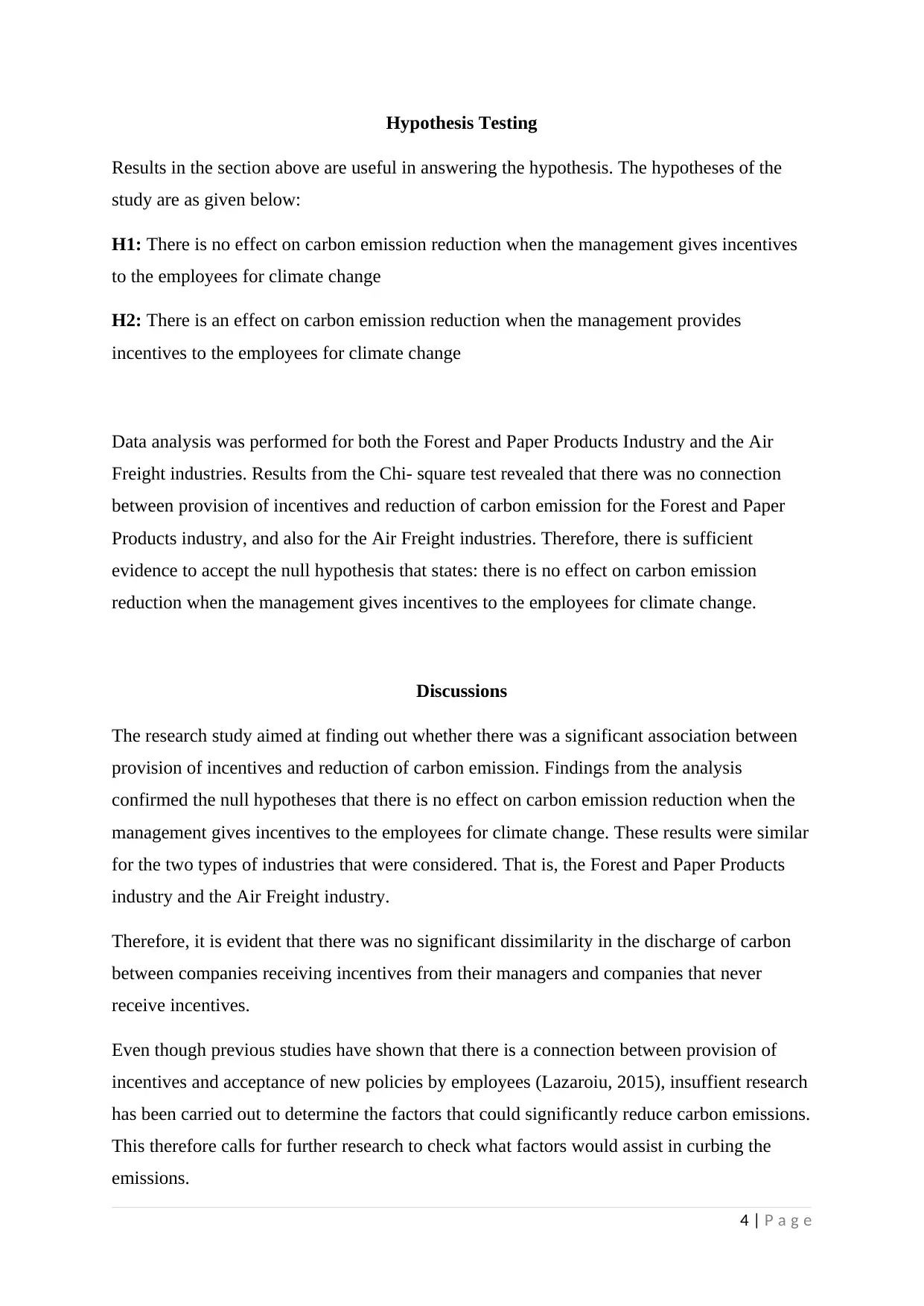
Hypothesis Testing
Results in the section above are useful in answering the hypothesis. The hypotheses of the
study are as given below:
H1: There is no effect on carbon emission reduction when the management gives incentives
to the employees for climate change
H2: There is an effect on carbon emission reduction when the management provides
incentives to the employees for climate change
Data analysis was performed for both the Forest and Paper Products Industry and the Air
Freight industries. Results from the Chi- square test revealed that there was no connection
between provision of incentives and reduction of carbon emission for the Forest and Paper
Products industry, and also for the Air Freight industries. Therefore, there is sufficient
evidence to accept the null hypothesis that states: there is no effect on carbon emission
reduction when the management gives incentives to the employees for climate change.
Discussions
The research study aimed at finding out whether there was a significant association between
provision of incentives and reduction of carbon emission. Findings from the analysis
confirmed the null hypotheses that there is no effect on carbon emission reduction when the
management gives incentives to the employees for climate change. These results were similar
for the two types of industries that were considered. That is, the Forest and Paper Products
industry and the Air Freight industry.
Therefore, it is evident that there was no significant dissimilarity in the discharge of carbon
between companies receiving incentives from their managers and companies that never
receive incentives.
Even though previous studies have shown that there is a connection between provision of
incentives and acceptance of new policies by employees (Lazaroiu, 2015), insuffient research
has been carried out to determine the factors that could significantly reduce carbon emissions.
This therefore calls for further research to check what factors would assist in curbing the
emissions.
4 | P a g e
Results in the section above are useful in answering the hypothesis. The hypotheses of the
study are as given below:
H1: There is no effect on carbon emission reduction when the management gives incentives
to the employees for climate change
H2: There is an effect on carbon emission reduction when the management provides
incentives to the employees for climate change
Data analysis was performed for both the Forest and Paper Products Industry and the Air
Freight industries. Results from the Chi- square test revealed that there was no connection
between provision of incentives and reduction of carbon emission for the Forest and Paper
Products industry, and also for the Air Freight industries. Therefore, there is sufficient
evidence to accept the null hypothesis that states: there is no effect on carbon emission
reduction when the management gives incentives to the employees for climate change.
Discussions
The research study aimed at finding out whether there was a significant association between
provision of incentives and reduction of carbon emission. Findings from the analysis
confirmed the null hypotheses that there is no effect on carbon emission reduction when the
management gives incentives to the employees for climate change. These results were similar
for the two types of industries that were considered. That is, the Forest and Paper Products
industry and the Air Freight industry.
Therefore, it is evident that there was no significant dissimilarity in the discharge of carbon
between companies receiving incentives from their managers and companies that never
receive incentives.
Even though previous studies have shown that there is a connection between provision of
incentives and acceptance of new policies by employees (Lazaroiu, 2015), insuffient research
has been carried out to determine the factors that could significantly reduce carbon emissions.
This therefore calls for further research to check what factors would assist in curbing the
emissions.
4 | P a g e
Paraphrase This Document
Need a fresh take? Get an instant paraphrase of this document with our AI Paraphraser
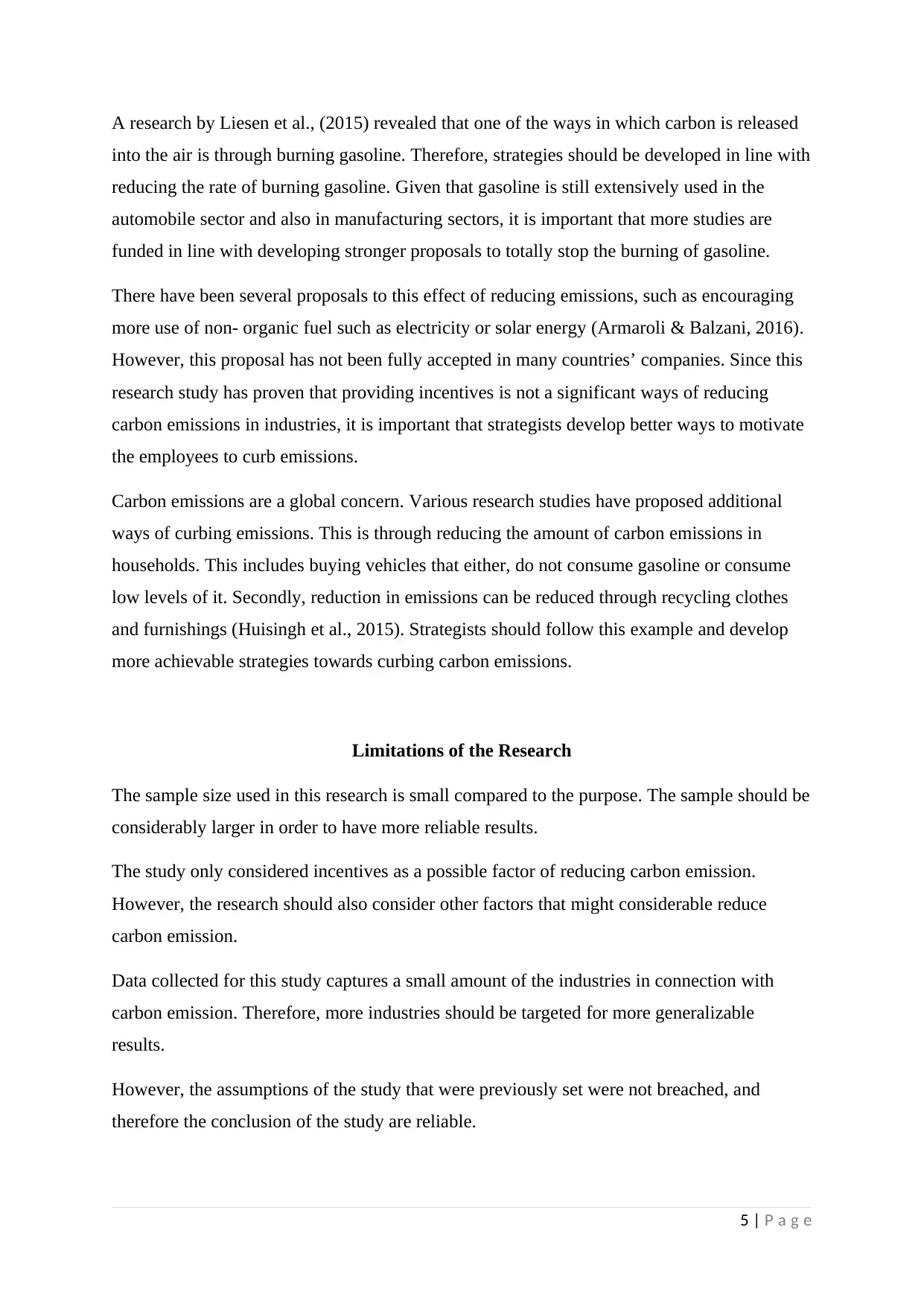
A research by Liesen et al., (2015) revealed that one of the ways in which carbon is released
into the air is through burning gasoline. Therefore, strategies should be developed in line with
reducing the rate of burning gasoline. Given that gasoline is still extensively used in the
automobile sector and also in manufacturing sectors, it is important that more studies are
funded in line with developing stronger proposals to totally stop the burning of gasoline.
There have been several proposals to this effect of reducing emissions, such as encouraging
more use of non- organic fuel such as electricity or solar energy (Armaroli & Balzani, 2016).
However, this proposal has not been fully accepted in many countries’ companies. Since this
research study has proven that providing incentives is not a significant ways of reducing
carbon emissions in industries, it is important that strategists develop better ways to motivate
the employees to curb emissions.
Carbon emissions are a global concern. Various research studies have proposed additional
ways of curbing emissions. This is through reducing the amount of carbon emissions in
households. This includes buying vehicles that either, do not consume gasoline or consume
low levels of it. Secondly, reduction in emissions can be reduced through recycling clothes
and furnishings (Huisingh et al., 2015). Strategists should follow this example and develop
more achievable strategies towards curbing carbon emissions.
Limitations of the Research
The sample size used in this research is small compared to the purpose. The sample should be
considerably larger in order to have more reliable results.
The study only considered incentives as a possible factor of reducing carbon emission.
However, the research should also consider other factors that might considerable reduce
carbon emission.
Data collected for this study captures a small amount of the industries in connection with
carbon emission. Therefore, more industries should be targeted for more generalizable
results.
However, the assumptions of the study that were previously set were not breached, and
therefore the conclusion of the study are reliable.
5 | P a g e
into the air is through burning gasoline. Therefore, strategies should be developed in line with
reducing the rate of burning gasoline. Given that gasoline is still extensively used in the
automobile sector and also in manufacturing sectors, it is important that more studies are
funded in line with developing stronger proposals to totally stop the burning of gasoline.
There have been several proposals to this effect of reducing emissions, such as encouraging
more use of non- organic fuel such as electricity or solar energy (Armaroli & Balzani, 2016).
However, this proposal has not been fully accepted in many countries’ companies. Since this
research study has proven that providing incentives is not a significant ways of reducing
carbon emissions in industries, it is important that strategists develop better ways to motivate
the employees to curb emissions.
Carbon emissions are a global concern. Various research studies have proposed additional
ways of curbing emissions. This is through reducing the amount of carbon emissions in
households. This includes buying vehicles that either, do not consume gasoline or consume
low levels of it. Secondly, reduction in emissions can be reduced through recycling clothes
and furnishings (Huisingh et al., 2015). Strategists should follow this example and develop
more achievable strategies towards curbing carbon emissions.
Limitations of the Research
The sample size used in this research is small compared to the purpose. The sample should be
considerably larger in order to have more reliable results.
The study only considered incentives as a possible factor of reducing carbon emission.
However, the research should also consider other factors that might considerable reduce
carbon emission.
Data collected for this study captures a small amount of the industries in connection with
carbon emission. Therefore, more industries should be targeted for more generalizable
results.
However, the assumptions of the study that were previously set were not breached, and
therefore the conclusion of the study are reliable.
5 | P a g e
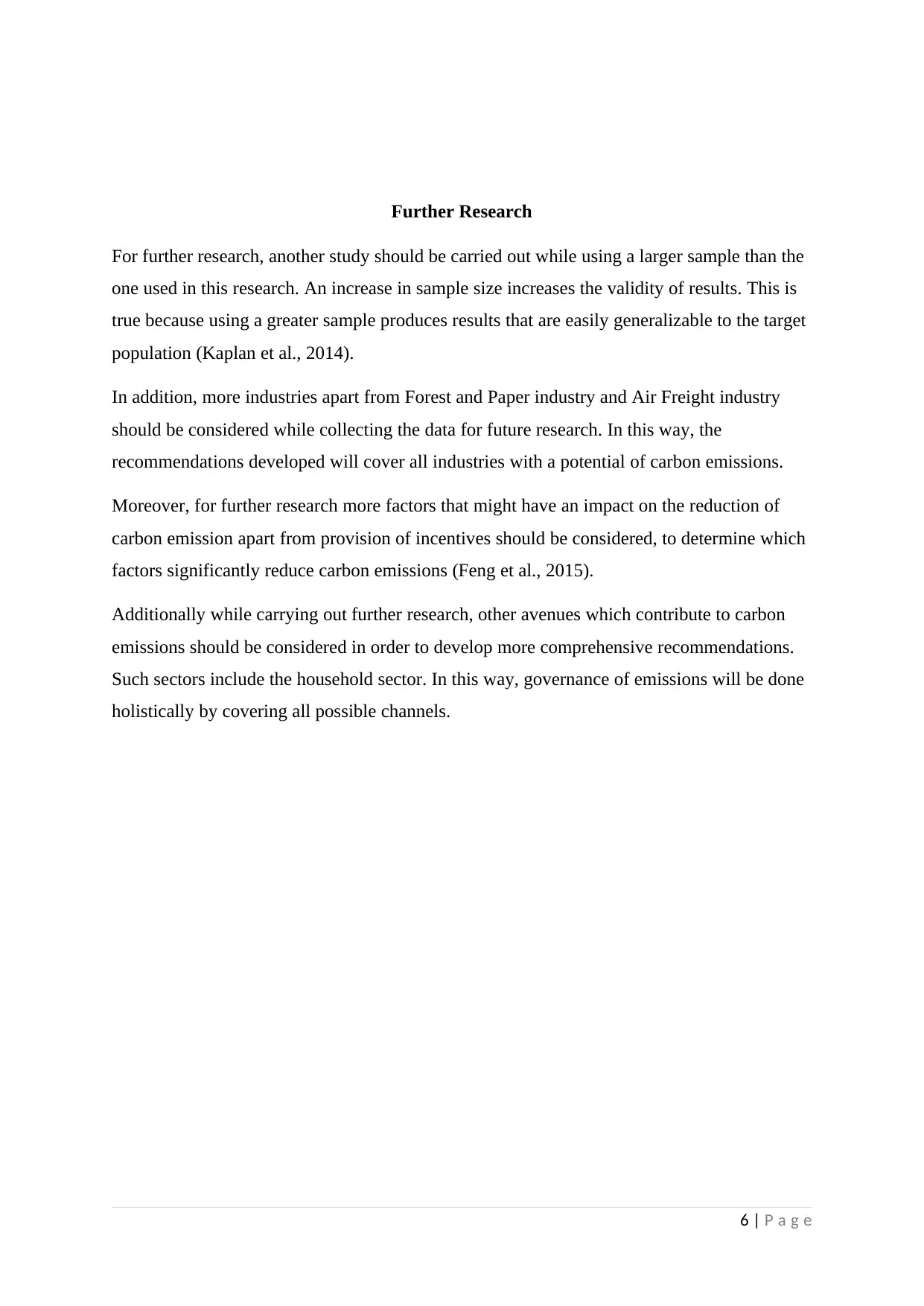
Further Research
For further research, another study should be carried out while using a larger sample than the
one used in this research. An increase in sample size increases the validity of results. This is
true because using a greater sample produces results that are easily generalizable to the target
population (Kaplan et al., 2014).
In addition, more industries apart from Forest and Paper industry and Air Freight industry
should be considered while collecting the data for future research. In this way, the
recommendations developed will cover all industries with a potential of carbon emissions.
Moreover, for further research more factors that might have an impact on the reduction of
carbon emission apart from provision of incentives should be considered, to determine which
factors significantly reduce carbon emissions (Feng et al., 2015).
Additionally while carrying out further research, other avenues which contribute to carbon
emissions should be considered in order to develop more comprehensive recommendations.
Such sectors include the household sector. In this way, governance of emissions will be done
holistically by covering all possible channels.
6 | P a g e
For further research, another study should be carried out while using a larger sample than the
one used in this research. An increase in sample size increases the validity of results. This is
true because using a greater sample produces results that are easily generalizable to the target
population (Kaplan et al., 2014).
In addition, more industries apart from Forest and Paper industry and Air Freight industry
should be considered while collecting the data for future research. In this way, the
recommendations developed will cover all industries with a potential of carbon emissions.
Moreover, for further research more factors that might have an impact on the reduction of
carbon emission apart from provision of incentives should be considered, to determine which
factors significantly reduce carbon emissions (Feng et al., 2015).
Additionally while carrying out further research, other avenues which contribute to carbon
emissions should be considered in order to develop more comprehensive recommendations.
Such sectors include the household sector. In this way, governance of emissions will be done
holistically by covering all possible channels.
6 | P a g e
⊘ This is a preview!⊘
Do you want full access?
Subscribe today to unlock all pages.

Trusted by 1+ million students worldwide
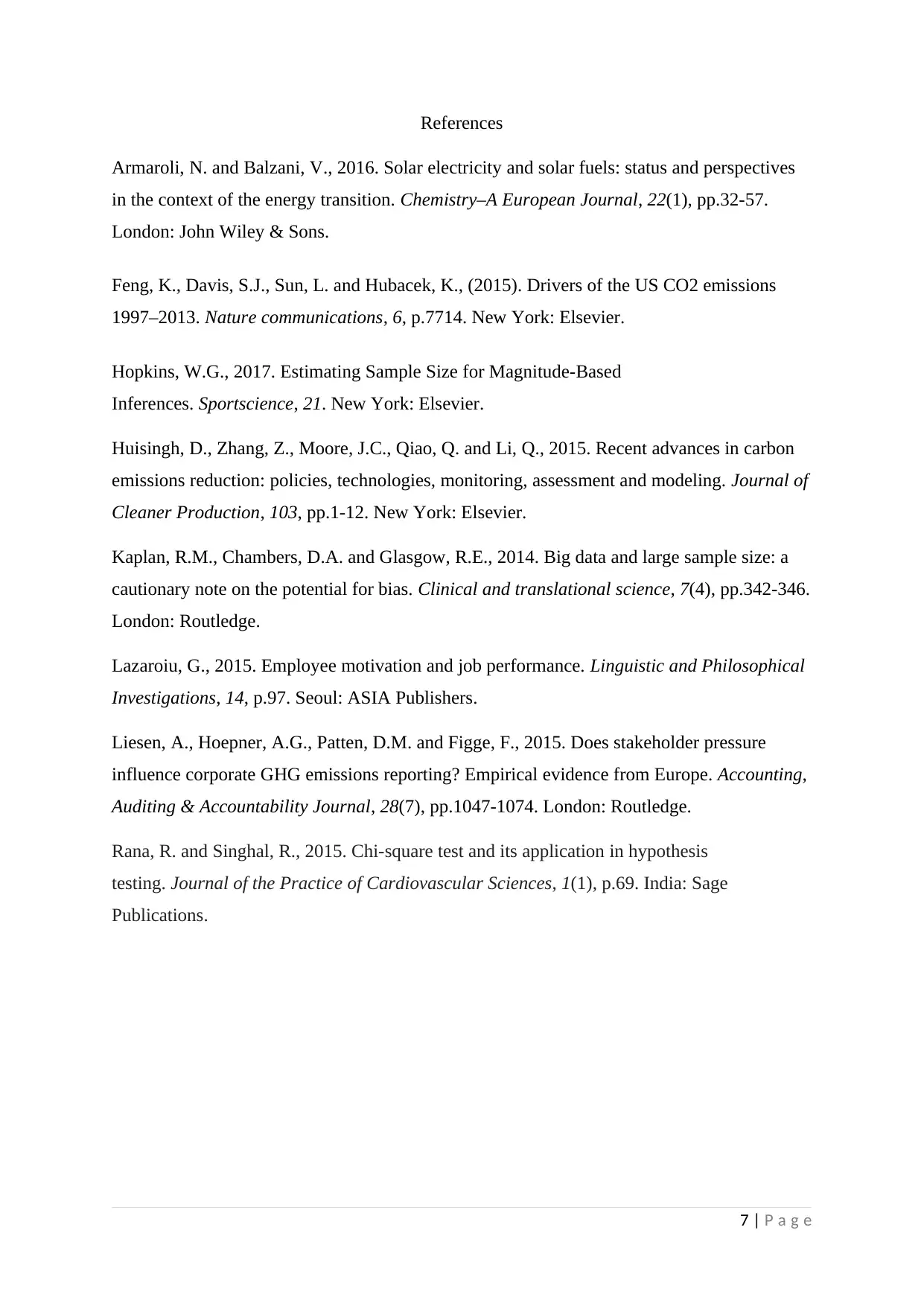
References
Armaroli, N. and Balzani, V., 2016. Solar electricity and solar fuels: status and perspectives
in the context of the energy transition. Chemistry–A European Journal, 22(1), pp.32-57.
London: John Wiley & Sons.
Feng, K., Davis, S.J., Sun, L. and Hubacek, K., (2015). Drivers of the US CO2 emissions
1997–2013. Nature communications, 6, p.7714. New York: Elsevier.
Hopkins, W.G., 2017. Estimating Sample Size for Magnitude-Based
Inferences. Sportscience, 21. New York: Elsevier.
Huisingh, D., Zhang, Z., Moore, J.C., Qiao, Q. and Li, Q., 2015. Recent advances in carbon
emissions reduction: policies, technologies, monitoring, assessment and modeling. Journal of
Cleaner Production, 103, pp.1-12. New York: Elsevier.
Kaplan, R.M., Chambers, D.A. and Glasgow, R.E., 2014. Big data and large sample size: a
cautionary note on the potential for bias. Clinical and translational science, 7(4), pp.342-346.
London: Routledge.
Lazaroiu, G., 2015. Employee motivation and job performance. Linguistic and Philosophical
Investigations, 14, p.97. Seoul: ASIA Publishers.
Liesen, A., Hoepner, A.G., Patten, D.M. and Figge, F., 2015. Does stakeholder pressure
influence corporate GHG emissions reporting? Empirical evidence from Europe. Accounting,
Auditing & Accountability Journal, 28(7), pp.1047-1074. London: Routledge.
Rana, R. and Singhal, R., 2015. Chi-square test and its application in hypothesis
testing. Journal of the Practice of Cardiovascular Sciences, 1(1), p.69. India: Sage
Publications.
7 | P a g e
Armaroli, N. and Balzani, V., 2016. Solar electricity and solar fuels: status and perspectives
in the context of the energy transition. Chemistry–A European Journal, 22(1), pp.32-57.
London: John Wiley & Sons.
Feng, K., Davis, S.J., Sun, L. and Hubacek, K., (2015). Drivers of the US CO2 emissions
1997–2013. Nature communications, 6, p.7714. New York: Elsevier.
Hopkins, W.G., 2017. Estimating Sample Size for Magnitude-Based
Inferences. Sportscience, 21. New York: Elsevier.
Huisingh, D., Zhang, Z., Moore, J.C., Qiao, Q. and Li, Q., 2015. Recent advances in carbon
emissions reduction: policies, technologies, monitoring, assessment and modeling. Journal of
Cleaner Production, 103, pp.1-12. New York: Elsevier.
Kaplan, R.M., Chambers, D.A. and Glasgow, R.E., 2014. Big data and large sample size: a
cautionary note on the potential for bias. Clinical and translational science, 7(4), pp.342-346.
London: Routledge.
Lazaroiu, G., 2015. Employee motivation and job performance. Linguistic and Philosophical
Investigations, 14, p.97. Seoul: ASIA Publishers.
Liesen, A., Hoepner, A.G., Patten, D.M. and Figge, F., 2015. Does stakeholder pressure
influence corporate GHG emissions reporting? Empirical evidence from Europe. Accounting,
Auditing & Accountability Journal, 28(7), pp.1047-1074. London: Routledge.
Rana, R. and Singhal, R., 2015. Chi-square test and its application in hypothesis
testing. Journal of the Practice of Cardiovascular Sciences, 1(1), p.69. India: Sage
Publications.
7 | P a g e
1 out of 7